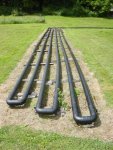It would be very helpful to me if some of you good folk who use solar heating for the pool could post your heater panels performance figures. i.e. flow rate and temperature rise in full sun and little or no wind. I need the information to see just how effective, or otherwise, my humble efforts have been.
A heater goodness factor could be obtained by multiplying the flow rate through the solar heater in US gallons per minute by the difference in temperature between the pool and the water returning to the pool having passed through the heater.
My figures for my DIY system with flow rates of 14.04, 9.36 and 5.46 gallons/minute and temperature rise of 9, 12.6 and 16.2 degrees Fahrenheit giving a goodness factor of 126.36, 117.936 and 88.452. This indicates to me that the higher the flow rate the better and that one could assume that high flow rates rather than high temperature rise suggests a more efficient system.
In case you prefer metric here are the figures in those units: Flow rate through the solar heated pipes 54 litres/minute 5 degrees rise (Celsius) on the return to the pool, 36 litres/minute 7 degrees rise, 21 litres/minute 9 degree rise. Pool is 75 000 litres and solar heated pipes are some 260 metres (853 feet) of 100mm (4 inch) plastic pipe painted black with non-reflective blackboard paint................JR.
A heater goodness factor could be obtained by multiplying the flow rate through the solar heater in US gallons per minute by the difference in temperature between the pool and the water returning to the pool having passed through the heater.
My figures for my DIY system with flow rates of 14.04, 9.36 and 5.46 gallons/minute and temperature rise of 9, 12.6 and 16.2 degrees Fahrenheit giving a goodness factor of 126.36, 117.936 and 88.452. This indicates to me that the higher the flow rate the better and that one could assume that high flow rates rather than high temperature rise suggests a more efficient system.
In case you prefer metric here are the figures in those units: Flow rate through the solar heated pipes 54 litres/minute 5 degrees rise (Celsius) on the return to the pool, 36 litres/minute 7 degrees rise, 21 litres/minute 9 degree rise. Pool is 75 000 litres and solar heated pipes are some 260 metres (853 feet) of 100mm (4 inch) plastic pipe painted black with non-reflective blackboard paint................JR.


